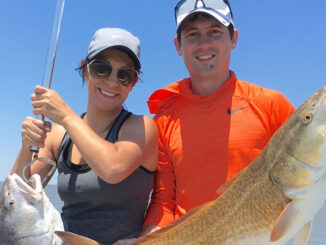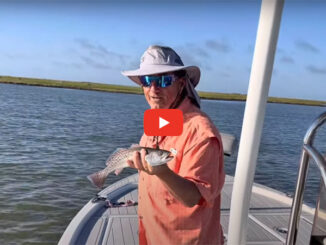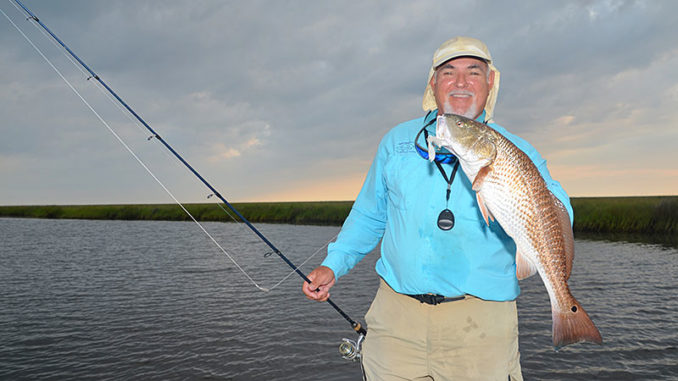
According to legend, when Mississippi entered the union, Louisiana and Mississippi authorities couldn’t compromise on exactly where to establish the border between the two states.
They finally agreed to float a barrel down East Pearl River to Lake Borgne and Mississippi Sound. Wherever the barrel drifted would become the new state boundary. As luck would have it, at least for the Louisiana people, prevailing currents kept the barrel fairly close to the present Mississippi coastline. Therefore, some of the best fishing around remained “in Louisiana.”
Today, the Biloxi Marsh, also called the Bayou Biloxi Marsh after a major stream in the area, or the Louisiana Marsh, juts out into Lake Borgne, Mississippi Sound and Chandeleur Sound east of New Orleans with Breton Sound to the southeast. These marshes spread across about 600 square miles of St. Bernard Parish due south of Waveland, Miss. They contain some of the best redfish habitat in the country. The Biloxi Wildlife Management Area conserves 35,644 acres of the marsh accessible only by boat.
Endless habitat
Anglers can depart from several Mississippi harbors and cross the Mississippi Sound. From Pass Christian Harbor, it takes about 20 to 30 minutes to reach the marshes. When venturing into stretches of open water, watch the weather carefully.
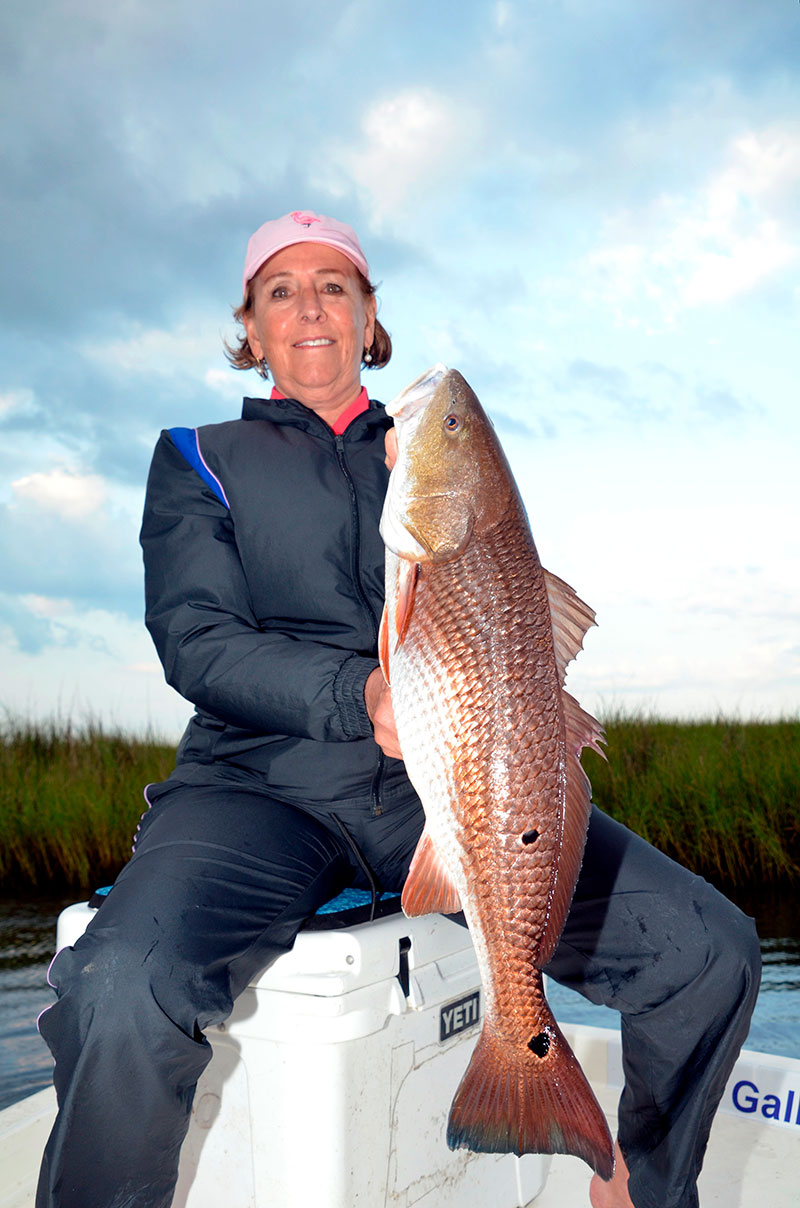
“We leave out of Bayou Caddy near Waveland, Miss., to go to the Biloxi Marshes,” said Sonny Schindler of Shore Thing Fishing Charters (228-342-2206, www.shorethingcharters.com) in Bay St. Louis, Miss. “It’s about nine or 10 miles to the Louisiana marshes. Those marshes are a paradise for fishing. It’s all perfect broken marsh shorelines with drains, ditches and endless habitat.”
People can also reach the area by traversing Lake Borgne from Slidell after about a 30- to 60-minute boat ride, depending upon the weather. Louisiana sportsmen can also access the marshes from Hopedale or Shell Beach through the old Mississippi River Gulf Outlet, better known as MRGO.
Completed in 1968, MRGO began as a shortcut for ships to reach New Orleans without fighting the Mississippi River current. The canal runs 76 miles from Breton Sound to the Gulf Intracoastal Waterway near the New Orleans Inner Harbor Navigation Canal, commonly called the Industrial Canal. The U.S. Army Corps of Engineers closed MRGO in 2009 by building a dam at Bayou La Loutre plus surge barriers at Bayou Bienvenue and across the Intracoastal Waterway. Restricting the water flow freshened the marshes, allowing aquatic grasses to grow.
When the Mississippi River gets high, freshwater flows through the Violet Lock into MRGO and out through the Biloxi Marshes toward the Gulf of Mexico. When the Mississippi River runs extremely low, like it did in 2023, the water becomes saltier. Double-digit salinity levels in 2023 killed much of the submerged vegetation.
“Blocking the MRGO definitely affected the area,” said Mike Gallo of Angling Adventures of Louisiana, (985-781-7811, www.AAofLA.com), who usually runs across Lake Borgne from his lodge in Slidell. “I’ve caught largemouth bass in the southern end of the marshes before. The Biloxi Marsh is a special place with some of the best redfish habitat in the nation. It’s just a far enough run so the area doesn’t get too much pressure. Therefore, fishing is a lot more consistent than some other areas.”
In the interior marshes, reds typically run from two to 20 pounds. Anglers might also catch bonus speckled trout, white trout, flounder, black drum, sheepshead and other fish. Major streams like Bayou Biloxi, False Mouth Bayou or Bayou Grande flow into Lake Borgne and produce good redfish action. The areas around Bay Boudreau, Lake Eugenie and associated marsh ponds also hold good fish.
Large lakes, bays
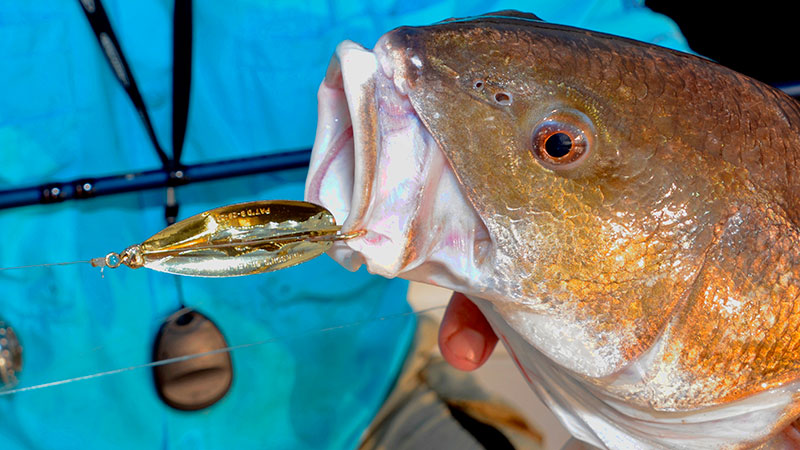
To the east closest to the Gulf, the marshes break up into large lakes and bays punctuated by grassy islands. Better places to catch redfish include Shell Island Lake, Drum Bay Three Mile Bay, Ninemile Bay, Jack Williams Bay and Deep Water Pass. At times, people can also catch Spanish mackerel, bluefish and other species that like more saline conditions.
“All of those islands are almost too tempting to fish,” Schindler said. “We focus on the areas with moving water, diving birds and bait. When we find that magic trifecta, that’s where the predators will be holding.”
Much hardier than speckled trout, redfish remain more active during the winter. In December, redfish periodically move from the deeper bayous and canals to the shallow flats and ponds to feed and then return to deeper water. Shallow water warms and cools much quicker than the depths. To a cold-blooded redfish, just a slight temperature increase could make a huge difference. As water becomes colder, shrimp and crabs become more scarce, so redfish mainly feed on mussels or other forage.
“The key to fishing the marsh in December is to find mullet,” Gallo said. “When we find mullet concentrations, we usually find a lot of redfish. Mullet hang out in shallower, warmer water.”
Crabby baits
In grassy areas, fish soft plastics on a Texas rig. Insert the hook point into a plastic craw to make the bait weedless. Use baits with blue claws, the same color as on live crabs. Some people like claws with a touch of red at the tips to mimic female crabs. Toss the lure against the bank and drag it out along the bottom like a crab foraging.
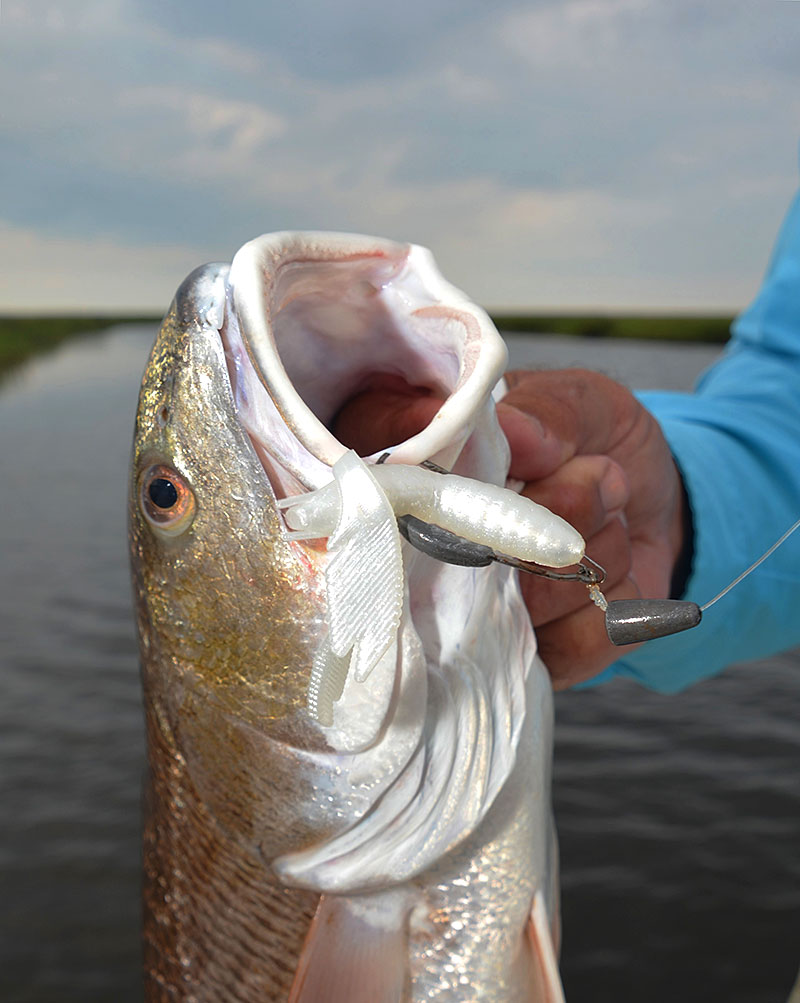
“I like to fish a Matrix craw on a Texas rig like for bass,” Gallo said. “Sometimes, I fish it a little faster when fish are more aggressive. When they are not as aggressive, I fish it slower. A gold or silver spoon is another good option to throw. It mimics a mullet pretty well. People can catch anything in that marsh with just a popping cork and fresh market shrimp. On warm days, we even catch some redfish on topwater baits during the winter.”
A live cocahoe minnow on a jighead makes an excellent winter temptation. Drag it along the bottom in short spurts. The struggling fish wriggling on the jighead provides enough enticement for any hungry redfish. In addition, the jighead creates a mud trail on the bottom like a scurrying crab.
In shallow marshes, move along slowly and stealthily. Noise vibrations transmit through the boat hull where fish can detect them. Use the trolling motor only sparingly on a low setting. Toss baits around points, pockets, little tributary mouths, isolated grass clumps or any other irregularities along the shoreline.
“Sound travels much farther on the water,” Gallo said. “When fishing shallow waters, I always wear a shirt to blend in with the background. If a person can see the fish, the fish can see the person.”
The islands on the eastern side tend to hold larger redfish. Some bull reds exceed 40 pounds. For giant spot-tails, tip a jighead or popping cork rig with a live finger mullet. Big reds also like cut mullet, fish strips, live pogies and cracked crabs.
“For the bulls, we fish a lot of live baits,” said Mark L. Wright with Legends of the Lower Marsh Guide Service (228-324-7612, www.legendsofthelowermarsh.com) in Gulfport, Miss. “When targeting redfish, I look for individual pieces of irregular broken residual grass and clumps that came off the main islands because of erosion. Depending upon the tidal flow, the backside of a bar creates a current break where bait collects. I also like to fish leeward points coming off islands with crushed shell and sandbar bottoms. That harder bottom holds crustaceans better, and redfish love crustaceans.”
Solitary bulls
Around the islands, water generally runs one to six feet deep. On the eastern side, the water also characteristically remains cleaner and saltier. In clear water, anglers can sight fish for individual spot-tails. Keep a rod handy to toss at any targets of opportunity.
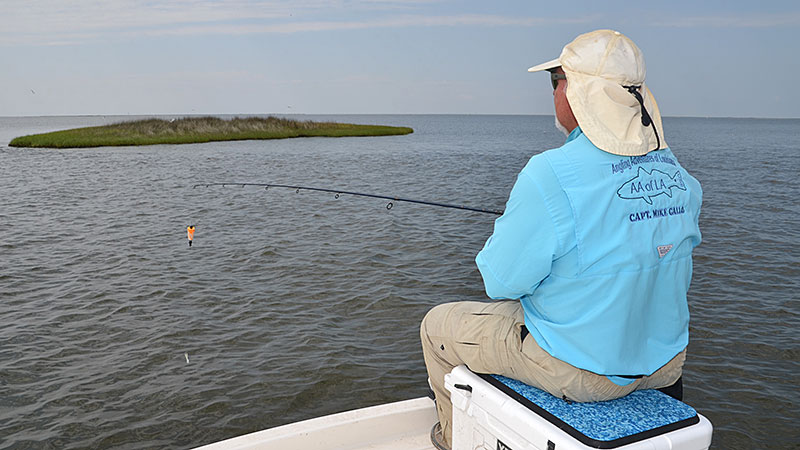
“By December, the big reds break out of their spawning schools and become more solitary,” Wright said. “We bounce from island to island looking for fish. In November and December, we normally fish gold spoons or queen-sized H&H cocahoes on a ¼-ounce leadhead. I also like to use swimbaits for bull reds. One of my favorites is a 5-inch Mann’s HardNose Swim Shad. I’ll also use a Matrix Shad with a ¼-ounce leadhead. Sometimes, I’ll go to a half-ounce leadhead, depending upon the water depth.”
Since the entire Biloxi Marsh area, including the outer islands, sits in Louisiana waters, everyone must possess a Louisiana license and abide by Bayou State regulations. Louisiana and Mississippi laws differ, but Mississippi anglers can bring Louisiana limits back to port. Make sure you know the rules before fishing here.
“If we have Louisiana limits in the boat, we cannot stop to fish in Mississippi waters on the way back,” Wright said. “I’ve been stopped by Mississippi game wardens before. If we have Louisiana sizes and limits, they want to see our Louisiana licenses.”
From November to January, many people hunt ducks on the Biloxi Wildlife Management Area. Anglers can go practically anywhere and catch fish, so there is plenty of room to leave the hunters alone. With so much habitat in that area, everyone can find a place to enjoy their favorite pursuits.
